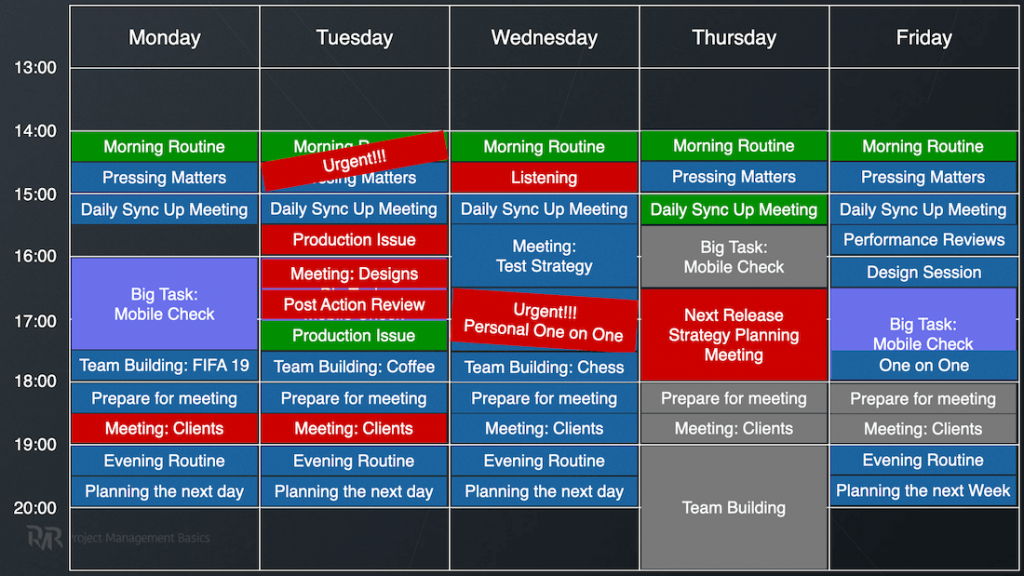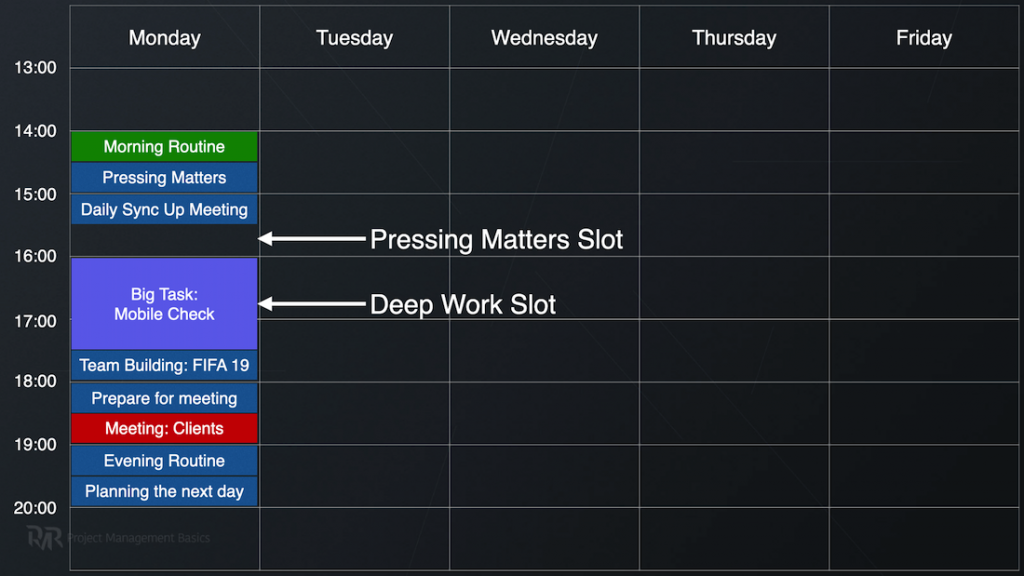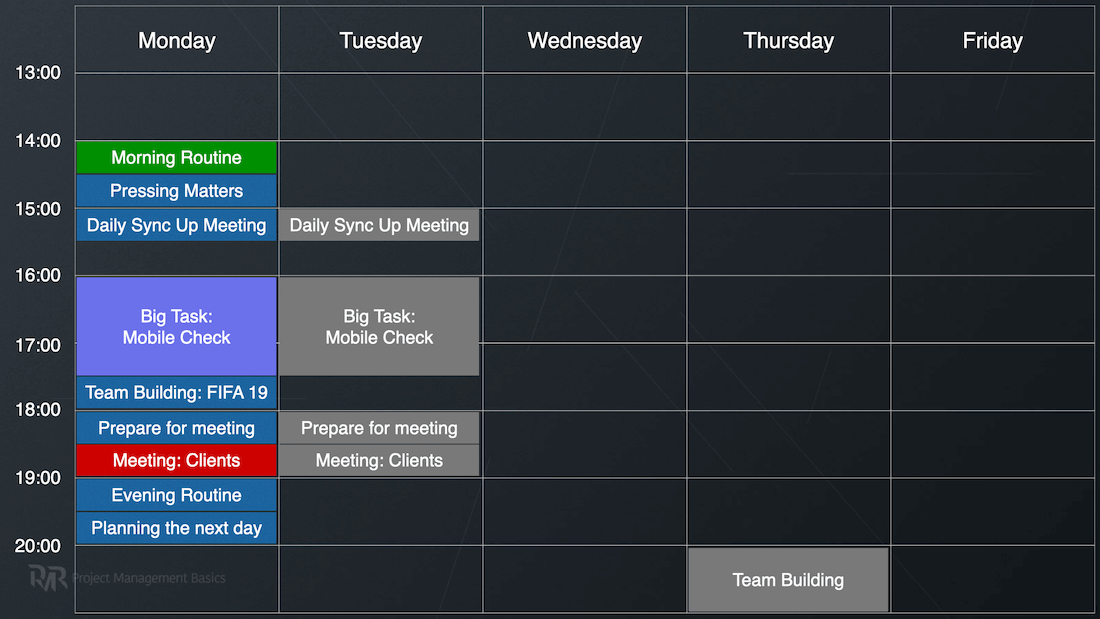
Day by day, I noted the significant events that happened on the project that I currently lead.
Here, I’ll describe all these events day by day. The best thing about it?
I share tons of great tips, tricks, and insights for real-world practical project management.
Let’s get started!
Monday: A Day in the Life of a Project Manager
And today is Monday.
So the first thing that I do when I come to an office in the morning routine.
Morning Routine of a Project Manager (30 minutes)
I’ve developed this routine throughout many years. It helps me make the start of the day as efficient as possible.
First, I reviewed all emails that came to me from the previous day.
Here, I apply a two-minute rule:
- If I can answer the question, answer the email in two minutes, I do it right away.
- If an email requires more time to answer, I plan this answer somewhere on this day or the next day (e.g., I need to collect information or prepare some more meaningful response)
- If it requires a lot of time, I put it into the calendar in one of the “deep work” slots.
Next, I review our task tracker.
Currently, it’s Microsoft Azure DevOps.
First, I check the burndown chart.
(If it looks normal, I may ignore all the rest and proceed to other tasks.)
Then, I look into the tasks that are currently in progress. I want to ensure that everyone works towards the deliverables that are currently the top priority.
Next, I review new defects and new tasks that may appear for the current assignments of team members.
But if I have some questions, I don’t interrupt the team’s work. I collect all the questions for the daily meeting that comes in an hour.
Quick Check-Up with Team Leads (10 minutes)
When I’m done with the morning routine, I continue collecting pressing matters from my team leaders.
They often communicate with other departments and other team members during the day and encounter some problems.
This way, I’m aware of what’s happening on their side and what’s on their plate.
As we’re co-located in one room, it’s just a shout-out to my team leads:
“Is there something important that I should know?”
For example, on Monday, I learned about a problem with the DevOps team. They didn’t correctly communicate that there was a problem with our system. So other team members didn’t know about this problem.
So, I do the morning routine and then collect pressing problems first thing in the morning to prepare for the daily sync-up meeting with the team.
This Monday wasn’t too active in the beginning. So, before the daily sync-up meeting, I spent the rest of the time answering other emails that I planned to.
Daily Sync-Up Meeting (30 minutes)
Next comes the daily sync-up meeting with the team.
I try to do it efficiently only once a day during the 30-minute meeting.
It is just a daily Scrum meeting.
Every team member reports what he was doing yesterday, what he is going to do today, and the main problems and challenges he or she is facing.
For me, it’s the main chance to align the team’s work towards the major deliverables that we should focus on.
But also, here, I delegate tasks based on the information that I got during the morning routine and collect all of the pressing matters.
Here’s an important thing:
In these meetings, we usually highlight the problems. We don’t discuss them directly here.
Two minutes rule comes into play again:
If we can’t resolve the problem in two minutes at the meeting, we move it to the time after the meeting. We spend these two minutes identifying the best next step.
Here’s a nice thing:
During this meeting, one team member said it would be good to have a drink together somewhere during the week.
Well, why not? It’s a great idea!
So we agreed to do that right in the office after work on Thursday.
Time Slot for the Most Pressing Metter
Right after the sync-up meeting, there’s a dedicated 30-minute time slot of free space.
Here, we discuss the major problems that we highlighted during the sync-up. We do it in smaller groups.
So, for example:
- One team member had to discuss some requirements with our business analyst.
- Another team member needed to clarify how to test new functionality with a QA engineer.
- I created an event for the small drinking party that we agreed to have.
As you see, sometimes issues on a project are pretty trivial.

My Deep Work Slot (1-1.5 hours)
After morning meetings with the team, I have a block of time for about an hour or an hour and a half to do some deep work.
Usually, I dedicate this period to some vital project management work that I need to do. Therefore, I shouldn’t be interrupted.
Let me walk you through.
I usually write some difficult emails or create reports, proposals, or update the project’s documentation.
I put my headphones on, turn off email, Skype, and other distractions. I even “disconnect” from the team.
What was the catch today?
I decided that to take a piece of the project work 🙁 (not project management).
It was a bad idea. You’ll learn why in the stories for the next few days. Keep on reading.
I want to test functionality where the application upgrades to the latest version.
So why did I choose to do this work myself rather than delegating it to other team members?
First of all, everyone is busy right now with top-priority tasks. And I want to check it as soon as possible.
Second, it requires efficient direct communication with the DevOps team. And with my authority as a project manager, I get responses much quicker.
So I tested the upgrade, but it didn’t work.
I had to write an email to the DevOps team. Shortly, they called me for a meeting to clarify the problem.
After that, they made some changes, and I retested. But it didn’t work again.
So, they wrote me that they needed more time to investigate the problem.
That’s fine because my time was running out for these activities.
Now, this is important…
During all this time, I wasn’t multitasking much.
There were some questions and answers from the team, but I stayed focused on finishing the task to the end.
Yes, it didn’t happen, but I did everything I could to resolve it right at this point.
Daily Team Building Effort
During the day, I usually dedicate some time to ongoing team-building activities.
However, on Monday, I combined the useful with pleasant.
I took one of my team members, and we went to a recreation room and played some FIFA on PlayStation.

Preparation for Daily Progress Report Meeting with Clients (30 minutes)
Next, I start to prepare for my daily meeting with clients.
By the way, it’s a great practice to have daily communication with your clients and key stakeholders. So if you can – you MUST arrange it.
Here’s the exciting part:
I lead this meeting for them to make it as efficient as possible.
We have a tracking list of items that we, as management and leadership, should resolve so that the project team can work without any impediments.
Here’s how I do it:
- I update this tracking list before the meeting.
- I collect all the essential topics I want to discuss with them and write them down there.
- I collect the information or results of work from the tasks that I delegated to team members.
And the final point about this process…
If the list of topics to discuss is too long and we cannot discuss it in the 30 minutes allocated, it’s my responsibility to prioritize this list and select only the most pressing problems.
Daily Progress Report Meeting with Clients (30 minutes)
We are in different time zones with clients. When they start their day when we are close to finishing it.
By the way, that’s why my working day is shifted towards the evenings so that we have some overlap with clients.
It’s a voice conference, and as I said, we get through our tracking list, and we resolve problems that impede our work.
If needed, clients can ask me to add something to this tracking list, and I will track it going forward.
Evening Routine of an IT Project Manager
So, after the daily meeting with the clients, I get into the evening routine.
First of all, I send the meeting notes, with all the actions that everyone needs to take.
Then, I respond to the urgent emails that came during this day.
I can almost hear you thinking…
Yes, I do try to respond to emails only twice a day.
Let me explain.
If there’s something urgent and I need to respond as soon as possible, people will write me an instant message or call me directly.
As you might have noticed, I am working part-time right now. So I’m 75% engaged in the project and 25% involved in recording these videos.
Also, clients and stakeholders may provide some input or a request at the end of our day.
That’s why I need a short meeting with my team leaders to add just the team’s work in the morning while I am not in the office.
Planning Out Activities for the Next Day
And last but not least, I plan my next day.

As you can see, right away:
- I have a daily stand-up meeting.
- I have my block for deep work that I didn’t finish yesterday.
- And I have my regular preparation for and meeting with clients.
- And for Thursday evening, I planned our team-building activities.
Tuesday was a mess. And if you want to learn how it went all to hell, keep on reading.
Tuesday: A Day in the Life of a Software Project Manager
Now let’s talk about my Tuesday.
So, as always, I planned to start my day with my morning routine.
This routine consists of:
- Checking mail
- Checking the task tracker
- Collecting information to delegate the work to the team members in our daily meeting.
I described the morning routine above.
Start of the Day Totally Messed Up
But the day became a mess once I stepped into the office room.
Right at the door, my business analyst says:
“We need to have a meeting with our design team. And YOU need to participate because their work is blocking us right now.”
Side note: While you may delegate tasks and responsibilities, not all of them will be finished on time. When it happens, there’s a need for some professional leadership.
He already scheduled that meeting during my Big Task time slot.
That sucks 🙁
But that’s not all!
To make it much funnier, my architect says that there’s a production issue. We need to investigate it as soon as possible.
But that is also not all as well!
My QA Lead says we need to discuss a test strategy for some features that we are working on right now.
So we need to have a meeting with them as well in the nearest future.
This comes with some experience, but actually, I don’t react to any of these things. I acknowledge them, and I continue with my morning routine.
Why?
Well, there might be even more important tasks in my inbox. I want to have the full list of problems first. Then, I can prioritize what needs to be done ASAP.
And guess what? I was right!
In the inbox, there’s an urgent request from clients that we need to test our application on iOS 13 that just came from Apple.

So, here’s how the to-do list looks like at the start of the day:
- Meeting with designers is already a fact.
- The production issue is something that we need to deal with right away.
- The Test Strategy meeting can wait a day or two
- And I can delegate the testing of iOS 13 to the QA team at the sync-up meeting.
- I committed to testing upgrade functionality for the mobile app yesterday.
High-priority Meeting: Troubleshooting Production Issues
I skipped answering emails as I usually do in the morning. I just wrote quick acknowledgments that we are working on all the issues already.
Then, I had to jump right in and facilitate the work of the investigation group to find the root cause of the production issue.
As you see this “Pressing Matters” time slot comes in handy. You’ll have a pressing matter on a daily basis.
So we discussed the problem with team leaders and worked out some assumptions that they need to check right now.
And I had to write an email to the DevOps team. They need to check another assumption as well. It’s quite possible the defect is not on our side.
So we finished our discussion just before the start of the daily sync-up meeting.
Daily Sync-up Meeting (Adjusted)
We compressed the usual part, where everyone reports on what they were doing, and dedicated this time to brainstorm ideas for the production issue.
I set the priority tasks for QA engineers to do this testing for iOS 13.
Right after the meeting, we continued to work on the production issue.
(Again, it’s a dedicated time slot for such cases.)
Everyone started communicating with other teams.
They started checking the assumptions that we made, which might have produced the issue, but nothing worked.
Nothing told us that the issue is on our side.
In such situations, time flies, and I had to leave the development team and run for the meeting with the designers.
“Poor Performance” Meeting with Designers
I knew from the start that this would be an unpleasant meeting.
When you need to push someone to do some work faster, it’s never pleasant.

Nevertheless, you need to do it professionally.
Hamburger Technique at Work
First, you start by acknowledging their hard work so far.
Then, you need to tell them about your concerns.
And you need to hear about their thoughts on the problem.
You need to slowly navigate through the problem areas so that you don’t hurt the feelings of people that you will be working with for the next few years.
Next, you need to cooperate to create an action plan that will make things done. Never make it personal. Make it a process or communication flaw.
All in all, this meeting was pretty productive. But it was emotional.
Right after it, we couldn’t get back to the development team and continue working on the production issue.
We worked out a collaborative approach to a more productive system. But some of my team members were still unsatisfied. They wanted some to be punished for the broken commitments.
You should never allow it.
So I had to spend another half an hour to move the outcomes of the meeting from emotional and personal to a professional landscape.
That’s why you need Risk Reserves and Slack in Schedule!
So when I finally went back to the development team, I learned that the production issue was not on our side. Such a waste of our nerves and time!
Nonetheless, it’s part of the process, and you can’t do anything about it.
You need to respond to such requests, but as a project manager, you should always have the reserve of time and effort to address all these requests and issues.
Micro Team-building Routine
As things slowed down a bit, I took time to have some team-building activities with my QA team.
We brewed coffee and went outside of the office to get some fresh air.

Everyone needed to vent some steam out on this front as well.
For sure we discussed this waste of time for the production issue, which was not on our side.
Daily Meeting with Clients
After that, I started to prepare for my daily meeting with clients.
So, I collected the test results for the iOS 13 that I delegated earlier today.
As always, we went through my tracking list.
New input!
They told us that there will be a long strategy planning meeting for the next release, so we need to make some preparations before it.
Another new task on our plate.
Side note: Your long-term project plan should include enough time reserves for all additional activities. It’s a real hassle when you need to change the plan and communicate it every time clients throughs something new to the team.
Evening Routine and Zero Inbox Technique
As usual, after the meeting, I sent the Meeting Notes and switched to my evening routine.
As I didn’t have much time today to answer all the communication that happened, I caught up during the last hour of the day.
Zero Inbox Technique
By the way, I keep to the rule of Zero Inbox.
It means that I don’t keep emails in my inbox unless I need to act upon them.
As soon as I’ve delegated the task or responded to an email, I archive it at once.
Sometimes, I pin some important emails so they’re at the top of my mind, but at the end of the day, I usually have one or maybe two emails that I already planned to answer the next day.
Planning the Next Day
By the way, we forgot one thing!
My Big Task for today.
I wasn’t able to finish testing the mobile upgrade that I took at the start of the week.
The DevOps team made some changes, and the ball is on my side now, and it’s a key takeaway for you:
You, as a project manager, do not have full control over your workday.
You have to make priorities of other people your priorities, so be careful when you assign some project work to yourself.
You can easily become a bottleneck.

Wednesday was a leadership day, and if you want to learn what I had to deal with – keep on reading!

